Final report for LNE17-356
Project Information
Consumer demand has increased for flour made from local wheat and ancient grains, produced both conventionally and organically, and farmers in the mid-Atlantic have an opportunity to expand their small grain operations to satisfy this growing market, diversifying their farms along the way. However, in the mid-Atlantic region, environmental conditions that promote disease development present challenges to excellent yields and grain quality. Farmers are not confident in how to properly identify these diseases, or of the best approaches to their management. Further, little information exists regarding varieties of ancient grains, like spelt, best suited to the growing region. In order to support the ability of regional farmers to expand into specialty grain production, we embarked on a study to determine which readily available spelt varieties may provide disease resistance and quality grain in Pennsylvania. We also offered educational programming to help farmers understand the crop production and disease management requirements of this lesser-known crop.
Variety trials were located at two on-farm sites and one research & extension center (PSU Southeast Ag Research & Extension Center (SEAREC), Lancaster County, PA) for three years. Researchers and farmers evaluated four and three varieties of spelt, respectively. These varieties were evaluated for incidence and severity of foliar diseases resulting from natural inoculum. Agronomic and milling qualities including yield, test weight, moisture, protein, falling number, and bread firmness and elasticity were also measured.
The trial results presented some important differences among varieties in terms of disease tolerance and other agronomic qualities or features such as lodging and straw production. The persistently wet field conditions during flowering and grain fill in 2018 created high disease pressure for most of the common wheat (and therefore, spelt) diseases in the region, and allowed for a good evaluation of potential resistance or tolerance among varieties. All varieties showed some level of infection by Fusarium head blight. Even under high disease pressure, all varieties at all locations maintained high quality through harvest. Analysis of yield data from organic production shows that all varieties yielded similarly in any given year, suggesting that farmers may prioritize preferred milling qualities or other agronomic features such as straw yield over grain production when choosing their variety.
Due to severely diminished outreach capabilities resulting from Covid-19 restrictions imposed in March 2020 and remaining in place through summer of 2021, the in-person field days and workshops had to be cancelled. Formats were moved to virtual webinars and other media where possible, but we fear impact for our growers without digital resources such as broadband access was curtailed. Virtual delivery of education took place through three unique events reaching over one hundred farmer, miller, maltster, and ag service provider registrants live. Further outreach is planned in order to provide this education to those with limited digital access. This project continues to have impact in educational and outreach events in 2022.
Fifty farmers will identify and manage heritage grain diseases and stored grain insects, subsequently decreasing yield losses by $100 per acre by 2020.Twenty-five farmers, representing over 1,000 acres in heritage grain production, will reduce input costs by $50 per acre using disease resistant varieties of spelt by 2021.
Spelt and other heritage grains are in increasing demand among consumers and millers as a specialty product. However, there is little information concerning best management practices available to farmers growing or interested in growing these crops in Pennsylvania. Further, there is no current information concerning the performance and relative disease resistance of available grain varieties in Pennsylvania. Farmers are seeking answers to their production questions, especially in regard to disease and stored pest issues.
An educational program was designed to increase farmer knowledge in the areas of heritage wheat production and pest management. Farmers shared knowledge with one another and took advantage of entomology and plant pathology expertise to become familiar with pest identification and management. The educational opportunities resulting from the project included field workshops, meetings, and conference presentations. These resources were targeted toward Pennsylvania growers, but were also made available to farmers, educators and crop consultants in the greater mid-Atlantic region.
In order to identify potential disease resistance in varieties that are well-suited to Pennsylvania, a research component of variety trials focused on spelt was located at one or two on-farm sites and one research & extension center (PSU Southeast Ag Research & Extension Center (SEAREC), Lancaster County, PA) for three years. Researchers and farmers evaluated five varieties of spelt, chosen in consultation with local millers and farmers. Varieties were evaluated for yield and disease, and analyzed for milling quality. Results have been and will continue to be shared through academic research articles, non-refereed publications and extension presentations.
Cooperators
- (Researcher)
- (Researcher)
- (Educator and Researcher)
Research
Differences in agronomic qualities, foliar disease susceptibility, and milling quality exist among currently available spelt varieties in Pennsylvania.
In order to evaluate the success of winter spelt varieties under Pennsylvania conditions, field plots were established at three locations in the fall of 2017.
At the Penn State Southeast Agricultural Research & Extension Center (SEAREC) in Manheim, PA, four spelt varieties (Comet, Maverick, Sonic, and Sungold, French's Hybrids Inc., Wakeman, OH) were planted on October 18, along with one winter wheat variety (MAS #4, Mid-Atlantic Seeds, York, PA) on October 19. In a no-till field, following soybeans, plots were seeded at a rate of 130 pounds per acre, 1 1/4" deep using a JD 1590 no-till drill (Video 1.). Plots were 10' by 75' and arranged in a randomized complete block design with six replications. Plots at this location were managed using conventional best management practices.
At both cooperating farm locations, Marshall Farms (Farm 1) and Small Valley Milling (Farm 2), three spelt varieties (Comet, Maverick, and Sungold, French’s Hybrids Inc., Wakeman, OH) were planted on November 3 and December 1, respectively. Following corn, both fields were plowed and disked prior to seeding. Plots were 30’ by at least 100’ and arranged in a randomized complete block design with four replications. Plots at cooperating farmers' locations were managed organically.
Research plots at the two on-farm locations were managed using organic methods while the plots located at SEAREC were topdressed with 60lbs of nitrogen per acre applied as 32% urea ammonium nitrate on April 7, 2018. Weeds were managed with an application of Harmony GT applied on the same date at 0.5 oz per acre at SEAREC. Stand counts were conducted at all sites when plants reached Feekes 6 growth stage.
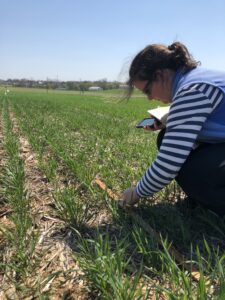
While powdery mildew was not observed in 2018 at SEAREC, moderate disease pressure was experienced and subsequently rated at the two on-farm sites. All sites reported additional foliar diseases such as tan spot and leaf blotch complex and were evaluated at early dough stage. Weather conditions were highly conducive to the development of Fusarium head blight (FHB) at all sites during the entire period of anthesis in 2018, and while not an initial target of this research, the decision was made to also capture FHB incidence and severity data at all three sites. This disease is of critical importance because of the associated production of mycotoxins.
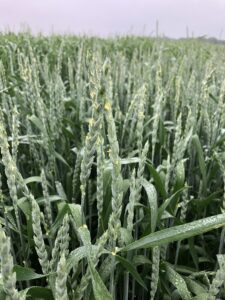
Research plots at all sites were harvested using a Wintersteiger Elite plot combine by taking the center meter of each plot (Video 2.). Harvested length ranged from 40' to 60'. The harvested material was weighed to determine yield and a subsample was taken from each for de-hulling and submission for further testing to evaluate milling qualities. Samples were cleaned, ground, and shipped to the Wheat Quality Lab at Kansas State University for quality analyses on instrumentation including Brabender Quadumat Senior and Farinograph as well as protein content, ash content, and falling number. Because small scale baling equipment was not available, straw yield was not measured on a tonnage basis, but straw length was recorded for all plots to provide a sense of straw potential of the varieties.
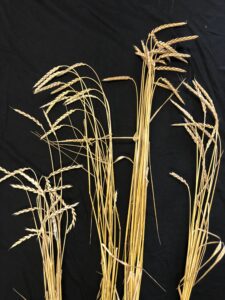
Spelt plantings for 2019 were again established in fall of 2018 at SEAREC and Marshall Farms, using the equipment and parameters stated above for the previous year. While cooperators at Small Valley Milling remained active participants in the project, they declined installation of study plots due to equipment and time constraints in this year of the project. The PIs appreciate their ongoing contributions to the project, including processing grain samples and serving as advisors. Varieties Comet, Maverick, and Sungold were planted at both sites while a fourth variety, Sonic, was included at SEAREC.
Management and evaluations of the plots were repeated as described above in 2019. Powdery mildew was present at Farm 1, along with other leaf blotch diseases, and rated accordingly. Powdery mildew was not observed at SEAREC, but septoria leaf blotch, leaf rust, and mild Barley Yellow Dwarf Virus was rated at this location. Fusarium head blight (FHB) did not appear at Farm 1, but was present at low to moderate severity at SEAREC. Harvest, yield measurements, and sample analysis took place as described above.
Plots for 2020 observation were established in October 2019 at SEAREC and Farm 1, and management practices were as described above. Disease pressure was very low during the spring and summer of 2020 due to dry conditions, but foliar and head disease symptoms were rated when observed. Lodging was also rated.
In order to conserve funds, 2019 and 2020 samples were batched together and are in process at KSU for milling quality analyses.
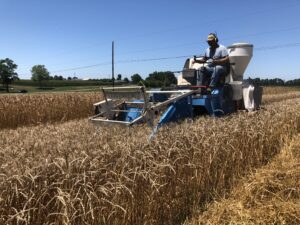
Video 1. PSU-Spelt-Planting
Senior Agronomy Technician, James Bollinger plants the spelt plots using a commercial-scale grain drill in a no-till field following soybeans.
Video 2. SEAREC-Spelt-Harvest
This video shows the harvest of the center meter of each plot using a research plot combine. Samples are captured and weighed to determine yield and conduct additional analyses. Notice the considerable difference in stature between the spelt being harvested and the wheat in the foreground.
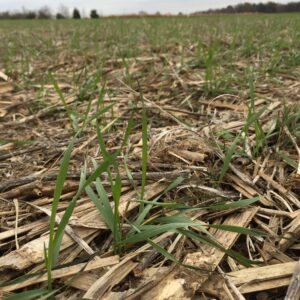
In all three growing seasons, spelt established well at all of the trial sites, and overwintered without any stand loss (Figure 1.). Performance at the SEAREC location remained strong for all varieties compared to other small grains, however weed pressure presented a persistent challenge at the cooperating on-farm organically managed sites. Grain ripened and was ready for harvest approximately 1-2 weeks after wheat crops.
Data collected through the evaluations above have were received for 2018 samples and are in analysis for 2019 and 2020 samples. The analysis and results of milling quality assessment will be shared in crop production meetings and conferences. An updated spelt production Extension factsheet is also planned. Initial results suggest some important differences among varieties in terms of potential yield, disease tolerance and other agronomic qualities or features such as lodging and straw production. The persistently wet field conditions during flowering and grain fill in 2018 created high disease pressure for most of the common wheat (and therefore, spelt) diseases in the region, and allowed for a good evaluation of potential resistance or tolerance among varieties to leaf diseases. Generally, all varieties at the three locations experienced similar levels of foliar diseases, with the exception of Sungold in 2018 at Farm 2 which had significantly less powdery mildew and leaf blotch severity compared to Comet and Maverick. In the year that wheat was grown as a part of the trial at SEAREC, all spelt varieties performed as well or better than wheat with regard to foliar disease severity. All varieties showed some level of infection by Fusarium head blight (FHB) (Figure 2.). Because of differences in date of anthesis among varieties, a meaningful comparison of FHB susceptibility cannot be made, but FHB incidence ranged from zero to eight heads affected out of 30 assessed. Future work in FHB should include application of mist and inoculation to determine relative levels of susceptibility among varieties.
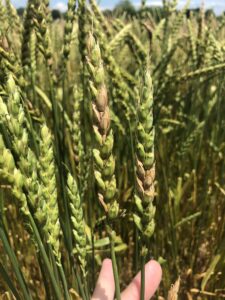
Some results for milling quality are shown below (Table 1). FN indicates Falling Number (a measure of sprout damaged grain; any number greater than 300 is desirable and indicates no sprout damage), while AC refers to Ash Content. Falling numbers of all varieties at all locations in all years remained above 300, with the exception of Maverick at SEAREC in 2019 and Comet at Farm 1 in 2020. Protein content was also measured by NIR, and optimum range is subjective depending on intended end-use. Sonic and Comet had similarly high levels at an average of 15.1% and 14.9% respectively, followed by Sungold at 12.6% and Maverick at 11.4%.
Table 1. Grain quality analyses of three spelt varieties grown at three locations, and one variety at one location from 2018-2020.
| MOISTURE CONTENT (%) | PROTEIN CONTENT (%) | FALLING NUMBER (SEC) | |
| 2018 | |||
| COMET | |||
| FARM 1 | 13 | 14.5 | 350 |
| FARM 2 | 12.7 | 14.2 | 371 |
| SEAREC | 12.8 | 16.2 | 352 |
| MAVERICK | |||
| FARM 1 | 13 | 10.4 | 360 |
| FARM 2 | 12.9 | 11.4 | 353 |
| SEAREC | 12.8 | 12.5 | 343 |
| SUNGOLD | |||
| FARM 1 | 12.9 | 11.2 | 372 |
| FARM 2 | 13 | 13.4 | 366 |
| SEAREC | 12.8 | 13.2 | 336 |
| SONIC | |||
| SEAREC | 12.6 | 15.1 | 353 |
| 2019 | |||
| COMET | |||
| FARM 1 | 14.4 | 11.7 | 361 |
| SEAREC | 12.9 | 11.7 | 329 |
| MAVERICK | |||
| FARM 1 | 14.4 | 9.8 | 342 |
| SEAREC | 13 | 9.4 | 281 |
| SUNGOLD | |||
| FARM 1 | 14.3 | 11.1 | 339 |
| SEAREC | 13.2 | 10.9 | 341 |
| SONIC | |||
| SEAREC | 12.8 | 11.8 | 453 |
| 2020 | |||
| COMET | |||
| FARM 1 | 11.1 | 10.4 | 287 |
| SEAREC | 12.1 | 9.8 | 327 |
| MAVERICK | |||
| FARM 1 | 11.2 | 8.8 | 333 |
| SEAREC | 12.5 | 7.7 | 349 |
| SUNGOLD | |||
| FARM 1 | 11 | 9.4 | 311 |
| SEAREC | 12.4 | 9.5 | 350 |
| SONIC | |||
| SEAREC | 12.2 | 10.7 | 389 |
Even in 2018, a wet year, all varieties at all locations maintained high quality through harvest, as indicated by falling numbers above 300.
Analysis of yield data from organic production shows that all varieties yielded similarly in any given year, with Sungold sometimes outyielding the other two (Figure 3.). This suggests that farmers may prioritize preferred milling qualities or other agronomic features such as straw yield over grain production when choosing their variety.
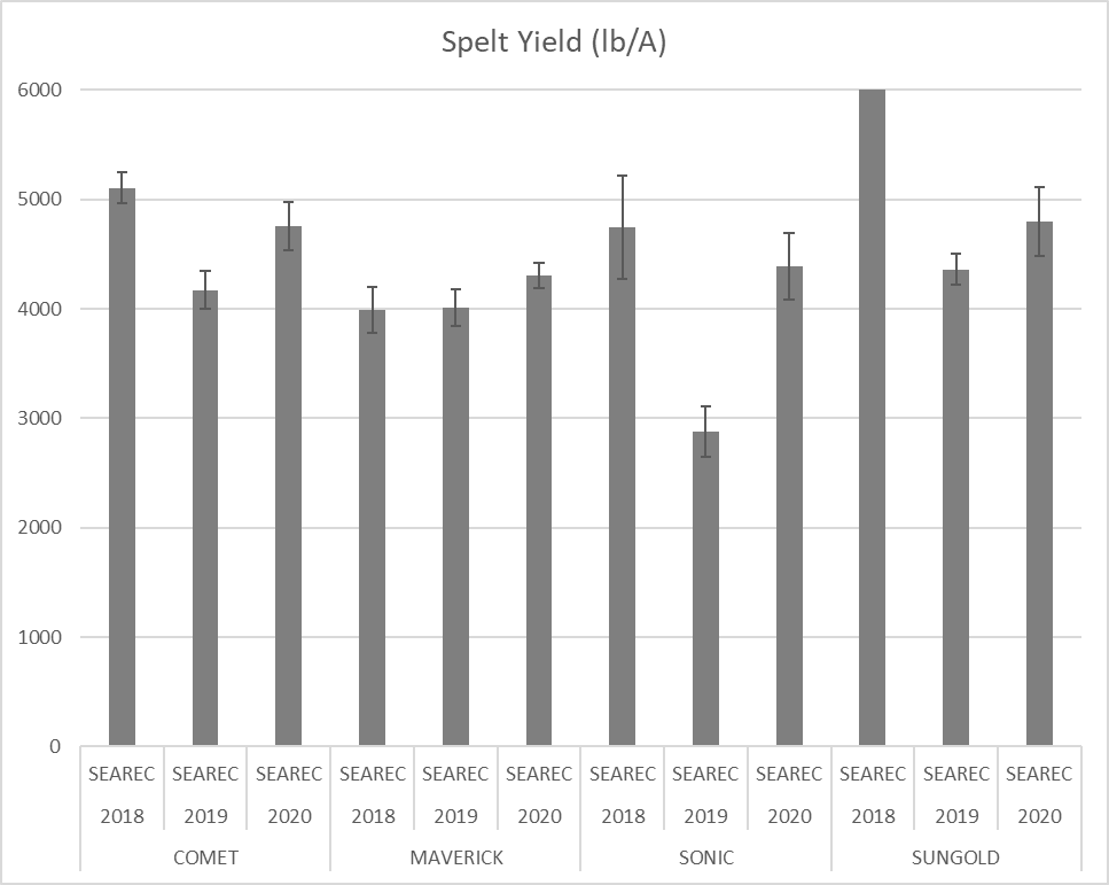
In summary, cv. 'Comet' was the shortest and earliest maturing variety, reaching around 34-36”. Cv. 'Maverick' was among the tallest of the varieties trialed at all locations (45-47"). Subsequently, it was the most prone to lodging, but not at every location every year. Due to its height, this variety has good straw potential and is early maturing compared to others. The latest maturing cultivar at all locations, 'Sungold', was also a tall variety at 46-49". Heading and anthesis (flowering) timing varied among varieties from a day up to a week.
Analyses for flour and baking quality were completed at the Kansas State University and results are being analyzed. We plan to author a publication to include agronomic, quality, and disease analyses, as well as an extension article to share results with growers and agricultural industry members.
Through working with farmer and miller cooperators as well as with varied equipment and in different conditions (tilled and no-till), researchers established some important conclusions and are able to provide recommendations accordingly.
The commercially available spelt varieties in the region (Comet, Maverick, and Sungold) yield in the range of 1000 to 1750 lbs/A of grain under organic management, and 2750 to 6000 lbs/A under conventional management in central Pennsylvania. No variety was consistently significantly better yielding in this study in every year. In both cropping systems, the trialed varieties performed similarly with regard to disease severity, with the exception of one variety at a single location one year (Sungold, which had significantly less foliar disease). Since all varieties showed some susceptibility to Fusarium head blight, growers should be careful to scout their crops prior to harvest and consider strategic harvest choices to mitigate mycotoxin contamination if FHB is detected. Some options may include prioritizing affected fields for harvest, adjusting the combine to remove the lighter affected kernels, and cleaning grain ahead of storage. The varieties generally maintained good grain quality across years and sites. With these results in mind, farmers should choose the variety that works best for their crop timing and straw production needs.
Among the varieties trialed at three locations, Comet was the shortest in stature, but also the earliest maturing variety, making this a good choice for a farmer planning to double crop following spelt. Sungold was the tallest variety and therefore promising for straw production, but was the last to reach maturity. Maverick closely followed Comet in maturity and also was among the tallest varieties, however this variety was more prone to lodging than the others in some years. Growers who wish to utilize this variety may consider monitoring fertility to ensure the appropriate levels of nutrients, including micronutrients, are applied according to soil tests.
Education
In working side by side with cooperating farmers, the research team adjusted the educational approach to meet grower needs in terms of event timing. In response to their feedback on appropriate times to host events, PIs created a series of three small grain production workshops which were scheduled take place in three geographic locations across Pennsylvania in March 2020.
Due to severely diminished outreach capabilities resulting from Covid-19 restrictions imposed in March 2020 and remaining in place through Summer of 2021, the in-person field days and workshops had to be cancelled. Formats were moved to virtual webinars and other media where possible, but we fear impact for our growers without digital resources such as broadband access was curtailed. A request for a no-cost extension was made in March to allow funds to support in-person activities in the 2021 program year, however, the restrictions on in-person programming were not lifted in time to produce events prior to the end of the project period.
To provide additional resources for educators, we created presentations for Extension Educators to use across the Commonwealth during grower meetings for the 2020 season and beyond, covering the production of high quality grains using variety selection and disease management. This presentation may be found here: Spelt Production Presentation: Spelt 2020 Additionally, a factsheet was created and distributed to farmers and ag industry professionals to help them learn about the options for organic disease control of wheat species.Fungicide chart updated 2022
Also planned was a targeted workshop/field day focused on small grains production, including diversity in crops, as well as featured presentations during our Farming for Success Field Day, and digital articles on these variety trials and small grain production. An example of a brief video field tour of the spelt varieties is included above. These events were conducted online in summer and fall of 2020. Our Small Grain Production Workshop (virtual) was held on October 29, 2020, with emphasis on pest management and a special session on considerations for spelt production in the MidAtlantic (selected presentation slides included above, file name: "Spelt 2020"). The foundation of this session was based on the field trials conducted through this project. Farmers with previous experience in spelt production were invited to share their experiences and learnings with the group, and generously did so. Attendees conveyed appreciation at the breadth of information offered, and appreciated the opportunity to learn from other growers who have worked with the crop. While many had some small grain production experience, they reported that the details learned through this session better prepared them for minimizing their risk while attempting a new crop.
Milestones
In 2017 and 2018 two Pennsylvania farmers and a miller will participate in on-farm spelt variety trials to evaluate yield, quality, and disease resistance with support from researchers. Prior to the fall planting season, researchers will meet with on-farm cooperators to discuss plot layout and select a potential field. We will assist the on-farm cooperators with marking and staking the trial during and after planting. A template will be provided to track inputs, expenses, changes, and other notes throughout the project. In the winter, an advisory board meeting will be conducted to prepare for spring data collection and generate a plan for harvesting in July. We will meet again in December to discuss the past field season and plan for the next season. This cycle will repeat throughout each year of the project.
6
1
2
1
October 15, 2020
Completed
December 31, 2020
Beginning in the 2017/2018 small grain season, two partner farmers (Joel Steigman & Dave Marshall) participated in the design of and established field variety trials mirroring the controlled trials installed at the Southeast Ag Research & Extension Center. These plots were observed, harvested, and data collected by the researchers, Collins and Bosak. While formal board meetings were not called, Dr. Bosak repeatedly met with both cooperators throughout the trial and plans were adjusted to meet the needs of the farmers. In 2019 and 2020, Joel Steigman chose to redefine his involvement with the project and participate instead in his capacity as an agricultural service provider (milling). His equipment made it difficult to install trial plots, but he remained a valuable partner in his capacity as a miller in processing samples and helping to assess the quality of the grain. Dave Marshall continued to execute the planned on-farm research plots in all three years.
Over the course of the project, seven site years of data were collected to evaluate 3 readily available spelt cultivars, and three site-years were gathered for a fourth cultivar. Yield, grain and flour quality, and other agronomic features were evaluated and characterized for each.
Seventy-five Pennsylvania farmers will learn disease diagnosis and proper stored pest management. This workshop will occur in spring, 2020 at SEAREC and will be regionally focused on Pennsylvania, Maryland, and Delaware.
75
126
May 22, 2020
Completed
December 31, 2021
The workshop we initially planned was not able to be held due to sudden restrictions on in-person programming in response to the pandemic. However, this education was delivered by 12 specialists at our Small Grain Production Workshop (virtual) held on October 29, 2020, with proper acknowledgments to NeSARE funding. Participants (76) engaged in 5.5 hours of small grains management education. The foundation of this session was based on the field trials conducted through this project. Farmers with previous experience in spelt production were invited to share their experiences and learnings with the group, and generously did so. Pesticide recertification credits and CCA credits were offered for these sessions.
In addition, the PIs gave a presentation to share insights from this project at the Philadelphia Grain & Malt Symposium (March 9, 2021) with growers, buyers, millers and other processors. This event also provided the opportunity to educate participants (50) on spelt diseases and their management. The NeSARE program was noted as a sponsor of this work verbally by the presenters and with visual attribution.
Further, the results and lessons from this work were shared with participants (20) at the PASA Sustainable Agriculture Conference (February 10, 2022, "Choosing Spelt Varieties and Identifying Small Grain Pests").
Fifty Pennsylvania farmers will increase their knowledge about spelt production and disease management approaches during guided field days. In spring 2020, a field day will be hosted in Lancaster County, in South
Central Pennsylvania. In spring 2020, a field day will also be hosted in Potter County, in Northern Pennsylvania, reaching audiences into Southern New York state.
50
June 25, 2020
Incomplete
Again, these field days became impossible when Covid restrictions were imposed in Spring 2020 and continued through Summer 2021. The virtual programming described above was delivered, and was well subscribed and received by participants. However, our ability to host participants in the field during the small grain season was completely precluded. We understand that this did not provide the level of education and engagement originally intended, and because digital programming is inaccessible to a significant portion of our stakeholders we fear we did not reach the full audience that may have benefitted from this work.
Because of this, we are now exploring innovative ways to provide this impact. For instance, we plan to provide factsheets in both digital and printable formats, delivered to ag service providers to share with their clientele. Another approach is the creation of "distance learning" packets which provide a comprehensive set of learning materials (production guide, disease and insect identification in color images) in hardcopy which is available by mail. These correspondence courses have been remarkably successful for other topics (it was piloted by Penn State Extension in 2020 with Forage and Pasture Diseases and Tomato Diseases), and also presents the opportunity for learners to earn pesticide applicator recertification credits. Approaches like this help us to reach our stakeholders who do not have access to internet resources or are members of plain sect communities.
Since this milestone remained incomplete during the scope of this sponsored project, funds that were earmarked for supporting in-person educational programming will be returned to the sponsor to ensure good financial stewardship.
Milestone Activities and Participation Summary
Educational activities:
Participation Summary:
Learning Outcomes
One hundred twenty-six participants in Penn State's Small Grains Production Workshop and the Philadelphia Grain & Malt Symposium received spelt production education supported by this project.
Post-event surveys conducted with participants through Qualtrics instruments delivered by the Penn State Extension digital communications team, with a response from 36, and informal feedback identified these as areas of knowledge change.
The key areas of learning were:
-farm diversification
-crop management (spelt)
-pest management (spelt diseases and storage pests)
-agricultural product storage and processing (dehulling, milling)
Performance Target Outcomes
Target #1
25
25 farmers will produce disease resistant varieties of spelt by 2021.
over 1,000 acres
Decreased yield losses by $100/acre and reduced input costs by $50/acre.
We were unable to verify change/adoption due to disruption of the project by the COVID-19 pandemic.
We were unable to verify change/adoption due to disruption of the project by the COVID-19 pandemic.
We were unable to verify change/adoption due to disruption of the project by the COVID-19 pandemic.
Because in-person programming was not conducted due to COVID restrictions, there were no mechanisms in place which would allow for the capture of information regarding grower practices and the changes/impacts/benefits resulting from increased learning. Regretfully, we were not able to devise an alternate method of determining impact apart from general learning increases following digital programming.
Similarly, we were unable to generate participants willing to be listed in SARE reporting beyond the named farmer and miller cooperators.
Additional Project Outcomes
Over the course of this project, overall interest in spelt as a crop remained steadily low among our traditional grower audience. However, new connections were made for extension professionals with seed companies, millers, and maltsters in the region. These connections will benefit growers by providing an expanded network of service providers, processors, and buyers if farmers choose to incorporate spelt as a tool for farm diversification.